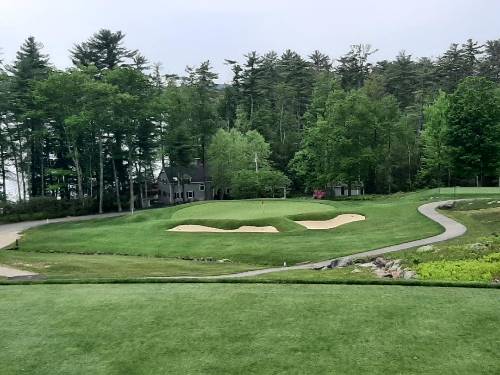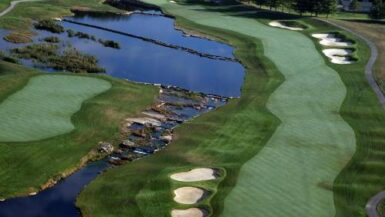
MOULTONBOROUGH, N.H. -You don’t see a lot of New Hampshire golf courses on many mainstream top-100 lists. Why not? When pundits discuss the best states for golf, they often overlook New Hampshire, and that’s a shame because Donald Ross, a colossus of golf course architecture, left behind a legacy of exceptional golf in the Granite State, easily the equal of many of his more celebrated courses nationwide.
Nestled in its own alcove of the White Mountains just adjacent to idyllic Lake Winnepesaukee, one of Ross’s Golden Age masterpieces, Bald Peak Colony Club, will celebrate its 100th anniversary this year, 2021. Bald Peak has everything going for it – everything that distinguishes a truly great golf course from a merely pretty good one. There’s exceptional vertical movement in the earth, with holes rising to noble heights or cascading down into thrilling drop shots. There’s excellent horizontal movement of the fairways, with bunkers, berms, and other hazards intersecting the line of play. And there are phenomenal green complexes and bunkering. Now having recently finished a highly successful restoration/renovation by golf architect Ron Forse and his partner Jim Nagle, Bald Peak is poised to re-emerge as a rising star and take its rightful place as one of the brighter jewels in the Donald Ross diadem.
Ross, a transplanted Scotsman, was one of the most prolific golf designers in history. Over 400 courses across America list him as their architect of record, but according to Brad Becken, president of the Donald Ross Society, the difficulty of traveling in the early 20th century made it impossible for Ross to spend a significant amount of time at each of the designs that now bear his name. And as Ron Forse once opined in an interview, he thought “about 48%” of the courses that claim Ross as their architect actually had him there on site during construction. He might not have even visited some, sending advice by mail or other means instead.
Happily, it’s clear from the historical record and from the golf course’s routing and construction that Donald Ross did enough significant work at Bald Peak Colony Club to count it firmly among the courses where he was indeed the primary architect of record and spent significant time on the build. There may have been the occasional suggestion here-or-there from Bald Peak founder, Thomas Plant, or his construction team, (as Ross was working other projects in New England and even elsewhere at the same time – Mid-Pines and Teugega most notably), and much of an original routing of playing corridors by a fellow named George Merritt may have predated Ross’s arrival, but Bald Peak looks and plays similar to – and at times even seamlessly with – its nearby brethren from the same period in Ross’s career arc, both earlier and later.
“Ross designed from 1900 up until his death in 1948, and you can divide his career by decades: 1900 to 1910, 1910-1920, 1920-1930, and so forth,” explained Becken. “In the decade of the 20s, Ross truly designed more courses than in all of the other decades combined.”
Ross was also close friends with the aforementioned Bald Peak founder, Thomas Plant, who Ross knew from Mid-Pines in North Carolina, another Ross classic of which Plant was a member. Indeed there had to be a great synergy between the two as numerous articles from the period link them to one another and to Bald Peak. They also were members of the “Tin Whistles,” one of the earliest golf social clubs in history.

We have an excellent record of Ross’s travels in this time period. In 1921 we know he was in Mid-Pines with Plant. He also certainly traveled to his frequent home of Rome, New York where he opened Teugega Country Club in the same year as Bald Peak. But he was also in New Hampshire as well, designing Bald Peak for Plant. What a trio of openings! Bald Peak, Teugega, and Mid-Pines: all lovingly restored in the last few years as well. Ross also designed nearby Manchester Country Club in 1923, Salem Country Club in 1924-5 (it opened in 1926), and Lake Sunapee Country Club, just an hour south of Bald Peak immediately thereafter. [Author’s Note: we wrote about Lake Sunapee C.C. here: https://jayflemma.com/lake-sunapee-country-club-new-hampshires-pin-on-the-american-golf-map/.] Ross was intimately involved those clubs on an almost daily basis. In the case of Lake Sunapee, he even got to select the site for the golf course.
By the time he arrived at Bald Peak, Ross was in the midst of achieving the escape velocity that would result in his full ascension as a premiere golf architect of that (or any) age. Bald Peak represents both a sharpening of some of the earliest arrows in his quiver, and his spin on some of the designs of holes in vogue during that period. But most importantly he still used what nature gave him and fit his ideas to the land where the terrain naturally accepted them.
“What characterized Ross by the time he got to the 1920s was the amount of internal contours and undulations in the greens and the hollows, depressions, false fronts and false sides that protected them,” Becken asserted energetically. You can hear the cheerfulness in his voice as he discusses is favorite subject, one he’s studied diligently for years. “Ross also used mounding – long grass-covered berms and mounds that would start outside the green, but then blend into it.”
“We’d been working on a master plan at the club for some time. Back in ’05-’06 we redid all the bunkers, and there were only 19 original bunkers of Ross’s, but well over 60 mounds and berms,” agreed Jim Nagle, Ron Forse’s partner in Forse Design and who came to manage the project in recent years. “Those were the main hazards.”
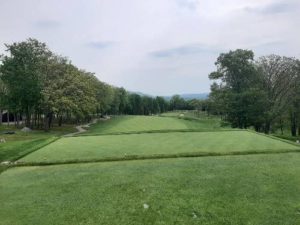
One such mound presents itself at the opening tee shot. Indeed, Bald Peak’s first hole says more architecturally in 298 yards than many modern golf holes can say in 498. A long grassy mound intrudes upon the fairway diagonally. A tee shot over it will reach a tongue of fairway or perhaps even the green. Any shot left or right is in long rough for a dicey pitch from an uneven lie to a severely undulating green.
Typical Ross: the adventure always continues upon reaching the green.
Indeed, great golf design is all about temptation, and an architect is always at his best when he lets you hang yourself with your own rope. That’s exactly what Ross does at Bald Peak Colony Club’s first: You want to try to drive over that berm…surely, you can do it, it’s a downhill shot; there’s even a tongue of fairway that leads to the green. Is it that bad if I miss hit it a little? I’ll have a wedge in my hand out of the rough. It’s only 298 yards! What a lollipop!
Next thing you know, you blocked it just a bit…and now you’re slashing out of shaggy, burly mounds, with a terrible angle to the flag. Â Suddenly that lollipop of a par-4 just threw a drink in your face, and you barely got started.
The berm theme continues successfully throughout the day, sometimes blending into the greens like at the second hole, or flanking the fairway like at the third and 16th. Better still, as you study the progress of Ross’s career, you can see the evolution of some of his ideas from Bald Peak at other courses.
“Ross designed wonderful berms and mounding in so many places: Salem, Teugega, Wompenaug, Essex County (MA), Charles River,” explained Becken. “Golf was evolving generally back then, and they were all looking at each others work and borrowing from each other.”
Perhaps nothing demonstrates that better than the par-3’s. Indeed as you review Golden Age par-3s though the years, you actually can see where Architect A at Course X may have doing a spin on what Architect B may have designed at Course Y. Moreover, Golden Age designers tended to repeat what worked before, making their own unique templates or their own variation on a common theme. And several of the par-3s at Bald Peak are Ross staples.

The most striking of the five par-3s is the “Battleship” 12th. It’s what some call a “Volcano Hole,” and what others call in the lexicon a “2 and 20 Hole,” (after the 13th at Engineer’s Club on Long Island, where Bobby Jones famously said, “You either get a two or a 20 on this hole…”). Fiendishly clever in its simplicity, the green rises up out of the earth into a pinnacle as though sculpted artfully. It’s not quite an all or nothing shot as the surrounds are not penal as at other courses, but it will take a delicate recovery shot to a topsy-turvy green.
“This is another design that, periodically, he used elsewhere,” Becken asserted energetically. “The third hole at Wannamoissett, the second at Irondequoit, the sixth at Country Club of Buffalo, the fourth at Bedford Springs Resort, and 8th at Misquamicut club in Rhode Island all come to mind.”
The remaining par-3s are equally spectacular. Bald Peak’s tiny, gorgeous, downhill par-3 fifth is another variation on a theme that Ross emulated throughout his career. The 15th, guarded by a lonely tree, features a treacherous false side. And everyone marvels at the distinct tiers of the 17th green, with one shelf a full five feet above the other plateaus.
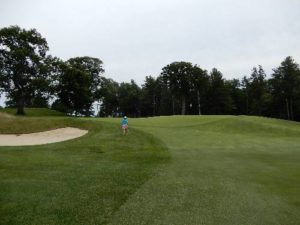
“One of the things I like most about the golf course is that it has five par-3s and five par-5s. In fact, the course finishes with a sequence that goes 5-3-5-3-5 over the closing five holes, which may be unique in American golf,” explained Forse. “That proves Ross let the lay of the land dictate the routing, and that’s why the golf holes flow so seamlessly over the terrain. Bald Peak’s routing traverses a lot of elevation change skillfully especially from the uphill holes that follow easier lines then those downhill.”
In another interesting feature of the routing, the course returns to the clubhouse at holes 11 and 15, as well as nine, so golfers can play short loops. It comes in handy for those members who need a little swing oil to avoid a back nine collapse. And it offers a quick chance for a short stretch of emergency holes, even though member play has exploded in recent years, Forse and Nagle’s renovation being so well-received.
“All we’ve done is try to restore the original Ross features and to add a little new bunkering or mounds that would have been what Ross would have designed,” Nagle confided. We added bunkers on the third fairway and five bunkers on 18, but that’s all. We also widened fairways, expanded nearly every green to the full size of its pad, and added internal contour on two or three. Finally, we added several shorter sets of tees, (including tees set in the actual fairway, blending seamlessly with it, as though you were teeing up in the fairway), and made sure that all the fairways flow seamlessly into the greens.”
Bald Peak is flawless, just like its nearby Donald Ross sister course, Lake Sunapee Country Club. Is New Hampshire the best kept secret in golf? It might be. And is Bald Peak the best of that bumper crop? It makes a strong argument. The golf world outside of New Hampshire is only now beginning to hear of Forse and Nagle’s triumph at Bald Peak, but word is spreading that once again a glorious Donald Ross Golden Age treasure has been rediscovered and polished to a high shine. Watch for not only fans of Ross himself, but Golden Age golf lovers everywhere to suddenly make the trek to the White Mountains…only this time, they won’t have their skis with them.
RIVER WALK
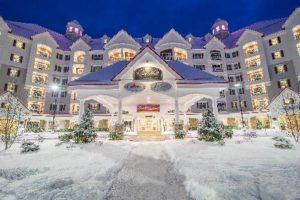
When in middle New Hampshire, there is only one completely civilized place to stay, and that’s the River Walk Resort at Loon Mountain. Only an hour up the road in Lincoln and adjacent to one of New Hampshire’s most iconic ski areas – fabled, venerable Loon Mountain – the River Walk recalls all the stately glory and glitter of the Golden Age of Hollywood, while also offering every modern amenity of the 21st century.
“We were going for something akin to the grand hotels of yesteryear, something like the Hotel del Coronado in San Diego,” said Dennis Ducharme, President of InnSeason Resorts, owner and operator of the River Walk stated in an earlier interview with Your Author. “We wanted something people would remember staying for the rest of their lives, one of the greatest hotels in America. That’s what we were going for.”
They succeeded to the fullest extent. The $33,000,000 development along the shores of the Pemi River sports 79 condominiums, each one – from the singles to the 2, 3, or 4-bedroom units or penthouse suites – each room with an enormous kitchens complete with their own island, spacious living rooms, huge bedrooms, and a balcony with mountain or valley views.
“JESUS! This is our room?!” gasped my slack-jawed playing partner/wingman for the trip as he first surveyed the palatial 2-bedroom, 2-bath suite that was ours for the weekend. It even had a balcony overlooking the swimming pool where we could look at the trails carved into the mountain beyond. “This is the best room I’ve ever stayed in!” he concluded energetically That’s high praise indeed, considering he’s visited nearly every major resort in Colorado and Utah.
My wingman is right. The River Walk is a diamond set in an emerald forest in the summer and fall, attracting outdoor enthusiasts with a galaxy of activities. And in winter, you’re slope-side to one of America’s most celebrated ski and snowboard venues. Heck some people don’t even need a reason to come to the River Walk…other than they love the spa, winery, restaurants, and ambiance.
“We come at least three times a year for a girls’ getaway weekend,” chirped a friendly permed brunette who sashayed over to our table with a drink in her hand. We didn’t catch her name, but she gave us more than one hair flip and a giggle, apparently a signature move of hers, which sent her friends into peels of laughter and knowing smirks.
“The wine is sublime, the service is impeccable, the digs are first class, and the bar scene sizzles,” she added. “Why would we escape anywhere else? This is heavenly.” And with that our new friends retired for a late-night dip in the Jacuzzi, certainly the best way to end any day filled with golf, skiing or lounging poolside.
Indeed both the restaurant and the winery have become wildly popular. The Italian fare at La Vista (open for breakfast and dinner) recalls the best cuisine of middle Italy. And Seven Birches Winery attracts visitors from all up and down the eastern seaboard and beyond. The vineyard is right in the backyard, and you can enjoy tours and tasting flights year-round. Using locally sourced fruits, they make cider as well.
“I’m gonna remember this place,” my wingman concluded, echoing the sentiments of every guest of the River Walk. “It’s the next best thing to owning a house slope-side or on the golf course.”


